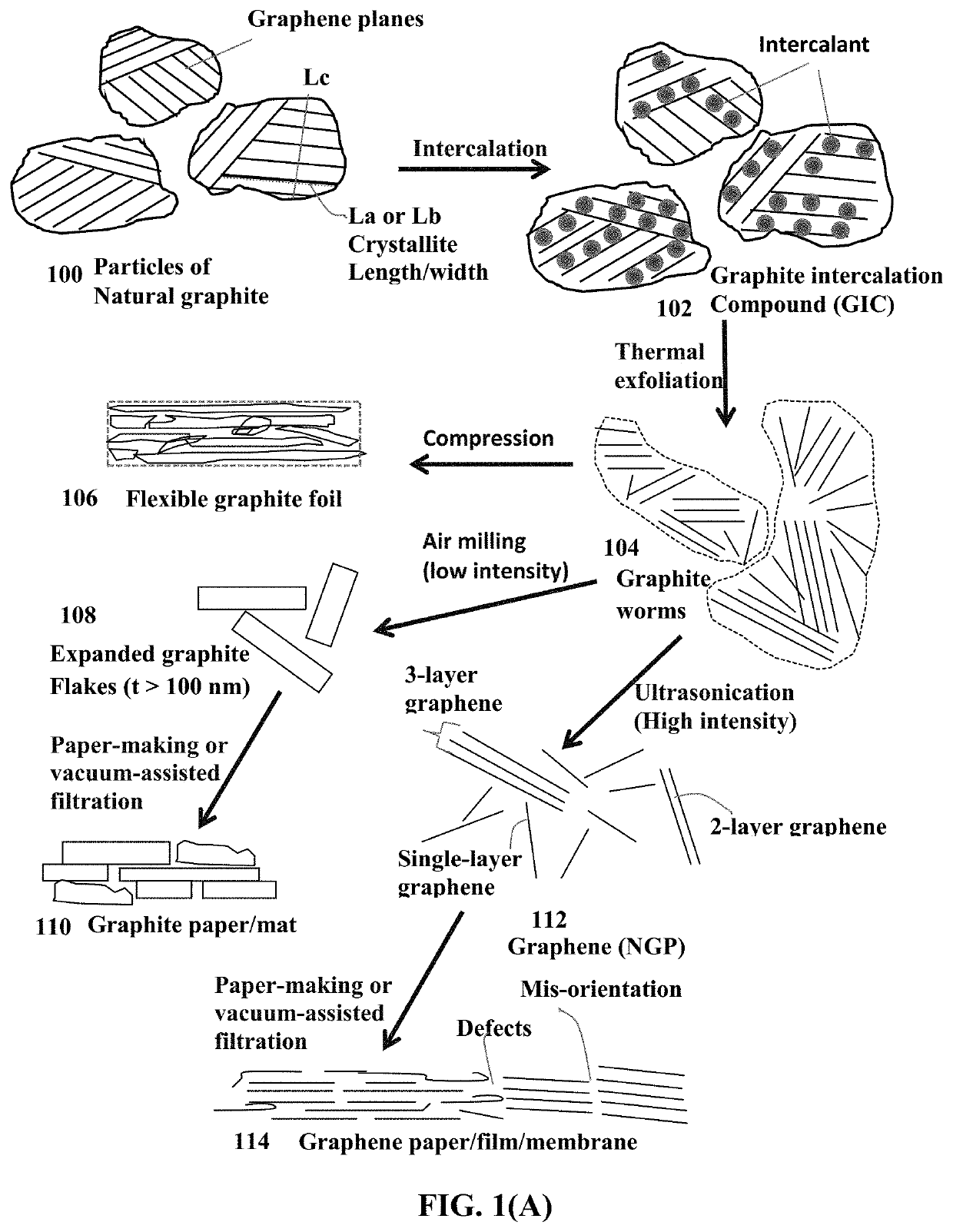Alkali metal-sulfur secondary battery containing a nano sulfur-loaded cathode and manufacturing method
a technology of nano sulfur and secondary batteries, which is applied in the manufacture of final products, cell components, electrochemical generators, etc., can solve the problems of state-of-the-art li-ion batteries that have yet to meet cost and performance targets, internal short circuit and explosion, and achieve low electric and ionic conductivities, simple, cost-effective, and easy-to-implement effects
- Summary
- Abstract
- Description
- Claims
- Application Information
AI Technical Summary
Benefits of technology
Problems solved by technology
Method used
Image
Examples
example 1
of Graphite to Produce Graphite Particles Having Expanded d Spacing
[0132]Natural flake graphite, nominally sized at 45 μm, provided by Asbury Carbons (405 Old Main St., Asbury, N.J. 08802, USA) was milled to reduce the size to approximately 14 μm (Sample 1a). The chemicals used in the present study, including fuming nitric acid (>90%), sulfuric acid (95-98%), potassium chlorate (98%), and hydrochloric acid (37%), were purchased from Sigma-Aldrich and used as received. Graphite oxide (GO) samples were prepared according to the following procedure:
[0133]Sample 1A: A reaction flask containing a magnetic stir bar was charged with sulfuric acid (176 mL) and nitric acid (90 mL) and cooled by immersion in an ice bath. The acid mixture was stirred and allowed to cool for 15 min, and graphite (10 g) was added under vigorous stirring to avoid agglomeration. After the graphite powder was well dispersed, potassium chlorate (110 g) was added slowly over 15 min to avoid sudden increases in temper...
example 2
and Intercalation of Various Graphitic Carbon and Graphite Materials
[0137]Samples 2A, 2B, 2C, and 2D were prepared according to the same procedure used for Sample 1B, but the starting graphite materials were pieces of highly oriented pyrolytic graphite (HOPG), graphite fiber, graphitic carbon nano-fiber, and spheroidal graphite, respectively. Their final inter-planar spacings are 6.6 Å, 7.3 Å, 7.3 Å, and 6.6 Å, respectively. Their un-treated counterparts are referred to as Sample 2a, 2b, 2c, and 2d, respectively.
example 3
on of Graphite Oxide from Natural Graphite and Needle Coke Using a Modified Hummers' Method
[0138]Graphite oxide (Sample 3A) was prepared by oxidation of natural graphite flakes (original size of 200 mesh, from Huadong Graphite Co., Pingdu, China, milled to approximately 15.mu.m, referred to as Sample 3a) and needle coke with sulfuric acid, sodium nitrate, and potassium permanganate according to the method of Hummers [U.S. Pat. No. 2,798,878, Jul. 9, 1957]. Anisotropic needle coke has a fully developed needle-shape texture of optical anisotropy. Volatile species of the raw coke was estimated to be around 5 wt. %.
[0139]In this example, for every 1 gram of graphite or needle coke, we used a mixture of 22 ml of concentrated sulfuric acid, 2.8 grams of potassium permanganate, and 0.5 grams of sodium nitrate. The graphite flakes were immersed in the mixture solution and the reaction time was approximately one hour at 35.degree. C. It is important to caution that potassium permanganate sho...
PUM
| Property | Measurement | Unit |
|---|---|---|
| specific energy | aaaaa | aaaaa |
| specific energy | aaaaa | aaaaa |
| energy densities | aaaaa | aaaaa |
Abstract
Description
Claims
Application Information
 Login to View More
Login to View More - R&D
- Intellectual Property
- Life Sciences
- Materials
- Tech Scout
- Unparalleled Data Quality
- Higher Quality Content
- 60% Fewer Hallucinations
Browse by: Latest US Patents, China's latest patents, Technical Efficacy Thesaurus, Application Domain, Technology Topic, Popular Technical Reports.
© 2025 PatSnap. All rights reserved.Legal|Privacy policy|Modern Slavery Act Transparency Statement|Sitemap|About US| Contact US: help@patsnap.com



